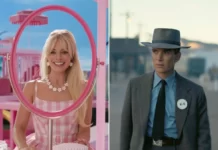Any reading about the Canadian experience often comes down to finding one’s place in the immigrant-heavy ever-changing land of Canada, and of course, that never-changing stoic beauty of Canada’s landscape.
Rather than a David Suzuki description of the life of BC animals, or a Viceland viewpoint of the different situations within British Columbia, Koneline (pronounced ko-nuh-lee-nay) takes the artistic route.
The film is a form of visual poetry tying typically beautiful Canadian landscapes of British Columbia, with engrossing soundscapes and songs. Carrying the movie are snippets of the various lives of the people, especially the Tahltan First Nation, who live on this land.
Director Nettie Wild laments that with the matters of mining as depicted in Koneline, the viewpoint often “all comes down to Indians versus miners.” But Koneline resists with a grey morality.
A group of Tahltan people form a protest in front of the local mine, and yet, we are shown native people drilling the land themselves.
We’re shown a white man hunting with a bow and arrow, as opposed to a pair of First Nations hunters using hunting rifles and a pickup truck. People acknowledge both their link to the land, and the need for power and jobs. The nature of people is shown to be as complex as the nature around them.
A linguist working towards his PhD studies the language of his father for the sake of attempting to preserve it. Here is where we finally learn the deeper meaning behind the name “Koneline.”
The linguist describes it as “our beautiful land” but moves on to stress that this means more. Koneline can also refer to the mind, the “cognitive landscape.”
It’s a revelation, a profound idea that shows the importance of archiving language to save such profound understandings of the world, and the nature of the mind’s relationship with its surroundings.
This movie may not be the best start for those looking for an introduction to the nature of First Nations in Canada.
Those students who have yet to really learn about the plight of Canada’s First Nations, their fight against the industrial use of their land or the horrors of the residential schools may be better served reading up on their Canadian history first. This movie will not explain.
Those who are squeamish or sensitive about animal cruelty may want to pass too. Native tradition and nature often mean hunting. Blood vividly pooling from a hole in a moose’s head, not to mention the carving of said moose’s body are displayed in gory detail.
However, it matches the non-judgemental, unflinching viewpoint Koneline possesses, a warts-and-all depiction of the native tradition of hunting.
Koneline is the particular type of art that is often mysterious and ponderous, and at its worst, impregnable and esoteric. This is not a film that will explain its people and their actions, and will only present them as an artifact to be viewed as it is without context.
That cognitive landscape varies with each person as it does with the actual landscapes they are set against. It is at once visually apparent, but obtuse and mysterious, waiting to be explored.
Within the last third of the film, the linguist points out the importance of repetition within the language of the Tahltan First Nation. This revelation coloured the film with new meaning. Repetitions of visuals gained new importance.
The repetition of power structures and helicopters, the recurrence of blood pooling onto the ground, becoming a puffed cherry red mass on the cold grass. Gently falling snow mirrored by another scene of falling puffs of seedpods fluttering by. A helicopter lowering a power line over the mountains and into place becomes a dance of construction workers fighting against wind with music evoking previous scenes of Native dance and ceremony.
Even the unnatural becomes beautiful. The movie is not judgemental of an orange-garbed worker taking in the scenery, a prospector surrounded by beautiful cylinders of mineral samples, or a mine opening a striking wound in the landscape.
I had only wished this crucial context of repetition and cognitive landscape had been at the beginning and not near the end. My English background laments the lack of context and structure to many of the scenes.
But perhaps this is missing the point. The wilderness of BC is the cognitive landscape of those who live there. Context can be unknown or unknowable, the structure as craggy and random as the rocky landscape.
While often esoteric and distant, Koneline provides plenty of poetry and mystery for those willing to take a look.
Koneline is playing at the Princess Cinemas Sept 16 to 22.






























